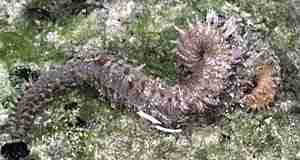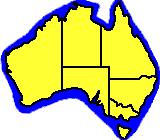|
|

Bristleworm Eurythoe complanata
Form:
The Bristleworm is distinguished by its long, stout body with only a few body segments.
Like Eunice aphroditois, it can shoot out its eversible mouthparts, called a pharynx, to catch prey.
Another name for the mouthparts is called a proboscis.
Eversible means that the long mouthparts are normally kept folded inside itself, like a pushed-in finger of a glove. When prey comes near, the mouthparts can be shot out to capture the prey. At the tip of the pharynx are hardened mandibles.
Its movement limbs, called parapodia, have two stems each. "Para" means "like" and "podia" means "legs". The gills are arranged in branching tufts alongside the parapodia.
Colour:
The Bristleworm's body is salmon-pink colour, while the numerous setae around its body form a characteristic snow-white fringe.
Phylum: |
Annelidae |
Author: |
Pallas |
Family: |
Amphinomidae |
Size: |
120 - 140 mm |
Distribution:
 This
species has a world-wide range and is widespread around Australia.
This
species has a world-wide range and is widespread around Australia.
Habitat:
It is common under rocks on coastal platforms or dead coral on sandy reef flats.
Biology:
The fringes on the movement limbs, which are called setae, or cirri, are made of extremely brittle calcium carbonate spikes. If you pick up one of these worms, you will soon find out why it is called a "Fireworm". Its setae spikes can stick into your fingers and break off, causing a very painful, long-lasting sting. The setae are hollow and contain venom, which can cause you great irritation and pain.
Questions:
Find an old plastic washing up glove and draw some mouthparts onto the tip of one finger. See Worms and Worm Feeds for details on how the mouthparts look and work. Describe in your own words what "eversible" means ?
Can you find any information about how painful the sting is from a Bristleworm ?
References:
Bennett, I. (1987) W.J. Dakin's classic study: Australian Seashores. p.184, Angus & Robertson, Sydney.
Davey, K. (1998) A Photographic Guide to Seashore Life of Australia. p.37, New Holland, Sydney.
Hutchings, P. (1984) A illustrated Guide to the Estuarine Polychaete Worms of New South Wales. p.55, Coastal Council of NSW & the Coast and Wetlands Society.
Shepherd, S.A. & Thomas, I.M. (1982) Marine Invertebrates of Victoria, Pt. 1. p.238, South Australian Government Printer, Adelaide.
Eunice
Bristle Worm
Galeolaria
Scale Worm
Peanut Worm
Home
Page
Taxonomy
Biogeography
Rocky Shores
Tidal Levels
Intertidal Zonation
Environmental Factors
Biological
Factors
Feeding Relationships
Activities
Glossary
References
 Life
on Australian Seashores
Life
on Australian Seashores
by Keith Davey (C) 2000
Learning Consultant
- Media
The University of Newcastle
email at australian_seashores@hotmail.com
Scientific Consultant: Phil
Colman
site created 01.01.98 : updated 01.04.2000